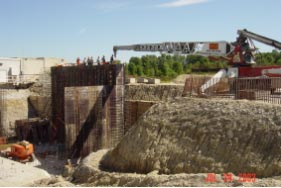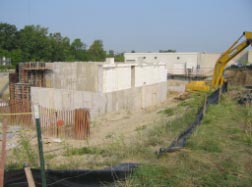Monday October 13 through Wednesday October 15
All shifts began in shutdown.
On Monday, technicians brought the Tevatron (TeV) vacuum for sector B3 up to normal atmosphere for scheduled work. Operations recovered systems from the planned ComEd site-wide power outage. Experts began turning on Linac systems, which included their Klystrons. Booster experts also turned on power supplies and the RF power amplifiers. CUB experts started chiller #3 to help regulate the temperature better for the Linac 55 LCW system.
On Tuesday, safety techs began testing the Linac safety system.
RECYCLER: Electron Cooling
In 1995 experts began to experimentally investigate the use of electrons to cool (reduce the energy of) an antiproton particle beam, a concept that was developed in the Soviet Union in 1974. The object of this cooling experiment was to increase the efficiency of the Recycler's ability to collect and store a denser and more uniform antiproton beam. To that end, Fermilab will install a tandem electrostatic accelerator in Recycler at MI-30 and 31.

Please be aware that the picture above is not precisely how the installation looks, but shows how it operates. The electron gun accelerates electrons from the gun (on the left) to the collector (on the right). These end parts, the gun and collector, will be housed in the new building pictured under construction below. The middle (drift tube) area is a straight section of the Recycler/Main Injector tunnel at MI-30, which is where the electrons interact and cool the antiproton beam.
How does this happen? Well, very basically, picture a red-hot cannon ball flying through space. The cannon ball is the antiproton. Now picture a small river moving in the same direction and at the same speed as the cannon ball. The river is made up of electrons and is much cooler than the cannon ball. (This is to give you some sense of scale between an antiproton and an electron.) As their two paths join, the cannon ball, which is traveling through the middle of the river, will give up a very small amount of energy to the river; it will cool down. Now picture this happening billions of times. What you end up with is a mass of still moving but very stable cannon balls, or as in our application, antiprotons.
The pictures below show various stages of building the enclosure, MI-31, that will house the electron accelerator.
 
These pictures show the building's relationship to beamline.
Accelerator Update Archive
More Information
For Tevatron luminosity charts and the current status of Fermilab's
accelerators and detectors (live!), please go to Fermilab Now
Comments and Suggestions
What do you think about the Accelerator Updates? Please send comments and suggestions to: accelupdates@fnal.gov.
|